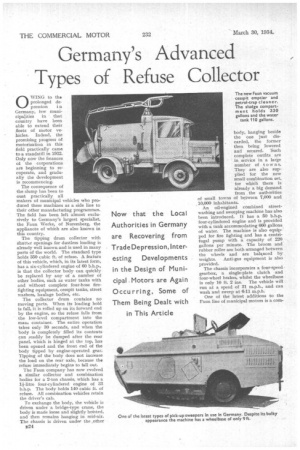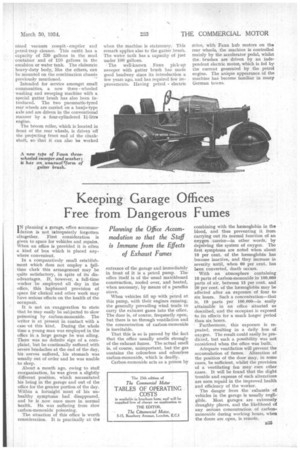Germany's Advanced Types of Refuse Collector
Page 30

Page 31

If you've noticed an error in this article please click here to report it so we can fix it.
WING to the prolonged de pression in Germany, few municipalities in that country have been able to extend their fleets of motor vehicles. Indeed, the promising progress of motorization in this field practically came to a standstill in 1932. Only now the finances of the corporations are beginning to recuperate, and gradually the development is recommencing.
The consequence of the slump has been to oust practically all makers of municipal vehicles who produced these machines as a side line to their other manufacturing programmes. The field has been left almost exclusively to Germany's largest specialist, the Faun Werke, of Nuremberg, the appliances of which are also known in this country.
The tipping drum collector with shutter openings for dustless loading is already well known and is used in many parts of the world. The standard type holds 350 cubic ft. of refuse. A feature of this vehicle, which, in its latest form, has a six-cylindered engine of 60 b.h.p., is that the collector body can quickly be replaced by any of a number of other bodies, such as water tanks with and without complete four-hose firefighting equipment, cesspit tanks, street washers, haulage bodies, etc.
The collector drum contains no moving parts. When its loading hold is full, it is rolled up on its forward end by the engine, so the refuse falls from the low-level compartment into the math. container. The entire operation takes only 30 seconds, and when the body is completely filled its contents can readily be dumped after the rear panel, which is hinged at the top, has been opened and the front end of the body tipped by engine-operated gear. Tipping of the body does not increase the load on the rear axle, because the refuse immediately begins to fall out.
The Faun company has now evolved a similar collector and combination bodies for a 2-ton chassis, which has a 14-litre four-cylindered engine of 33 b.h.p. The body holds 140 cubic ft. of refuse. All combination vehicles retain the driver's cab.
To exchange the body, the vehicle is driven under a bridge-type crane, the body is made loose and slightly hoisted, and then remains hanging in mid-air. The chassis is driven under the other B24 body, hanging beside the one just discarded, the former then being lowered and secured. Such complete outfits are in service in a large number of towns. They are also supplied for the new small combination set, for which there is already a big demand from . the authorities of small towns of between 7,000 and 10,000 inhabitants. An oil-engined combined streetwashing and sweeping machine has also been introduced. It has a 50 b.h.p. four-cylindered engine and is provided with a tank accommodating 660 gallons of water. The machine is also equipped for fire fighting and has a centrifugal pump with a capacity of 220 gallons per minute. The broom and rubber roller are both arranged between the wheels and are bal4nced by weights. Anti-gas equipment is also provided. The chassis incorporates a four-speed gearbox, a single-plate clutch and four-wheel brakes, whilst the wheelbase is only 10 ft. 2 ins. The vehicle will run at a speed of 31 m.p.h., and can wash and sweep at 6-11 m.p.h.
One of the latest additions to the Faun line of municipal motors is a corn
Dined vacuum cesspit emptier and petrol-trap cleaner. This outfit has a capacity of 330 gallons in the mud container and of 110 gallons in the emulsion or water tank. The elaborate heavy-duty body, like the others, can be mounted on the combination chassis previously mentioned.
Intended for service amongst small communities, a new three wheeled washing and sweeping machine with a special gutter brush has also been introduced. The two pneumatic-tyred rear wheels are carried on a banjo-type axle and are driven in the conventional manner by a four-cylindered 14-litre engine.
The broom roller, which is located in front of the rear wheels, is driven 'off the projecting front end of the crankshaft, sothat it can also be worked when the machine is stationary. This remark applies also to the gutter brush. The water tank has a capacity of just under 100 gallons.
The well-known Faun pick-up sweeper with gutter brush has made good headway since its introduction a few years ago, and has required few improvements. Having petrol electric drive, with Faun hub motors on the rear wheels, the machine is controlled mainly by the accelerator pedal, whilst the brushes are driven by an independent electric motor, which is fed by the current generated by the petrol engine. The unique appearance of the machine has become familiar in many German towns.












































































